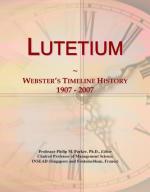|
This section contains 262 words (approx. 1 page at 300 words per page) |
Lutetium is the heaviest, rarest, and most expensive of the rare earth elements, the elements found in Row 6 of the periodic table between Groups 2 and 3. Lutetium's atomic number is 71, its atomic mass is 174.97, and its chemical symbol is Lu.
Properties
Lutetium is a silvery white metal that is quite soft and ductile. It has a melting point of 3,006°F (1,652°C), a boiling point of 6,021°F (3,327°C), and a density of 8.49 grams per cubic centimeter. The element reacts slowly with cold water and with most acids.
Occurrence and Extraction
Lutetium is thought to be very rare in the Earth's crust with an abundance of about 0.8-1.7 parts per million. The most common ore of lutetium is monazite, in which its concentration is about 0.003%. The metal is produced by first converting its ores to lutetium fluoride (LuF3) and then treating that compound with sodium metal: 3Na + LuF3 Lu + 3NaF.
Discovery and Naming
Lutetium was discovered almost simultaneously in 1907 by three researchers, George Urbain (1872-1938) of France, Karl Auer (Baron von Welsbach; 1858-1929) of Germany, and Charles James (1880-1926) of the United States. The element was one of nine new elements discovered in an unusual black rock known as ytterite first discovered in 1787 by a Swedish army officer, Carl Axel Arrhenius (1757-1824). The name of the element, suggested by Urbain, comes from the ancient name for the city of Paris, Lutecia.
Uses
Because lutetium is so expensive (currently, about $75 a gram), it has almost no commercial use. The one exception is that it is sometimes used as a catalyst in the petroleum industry.
|
This section contains 262 words (approx. 1 page at 300 words per page) |


